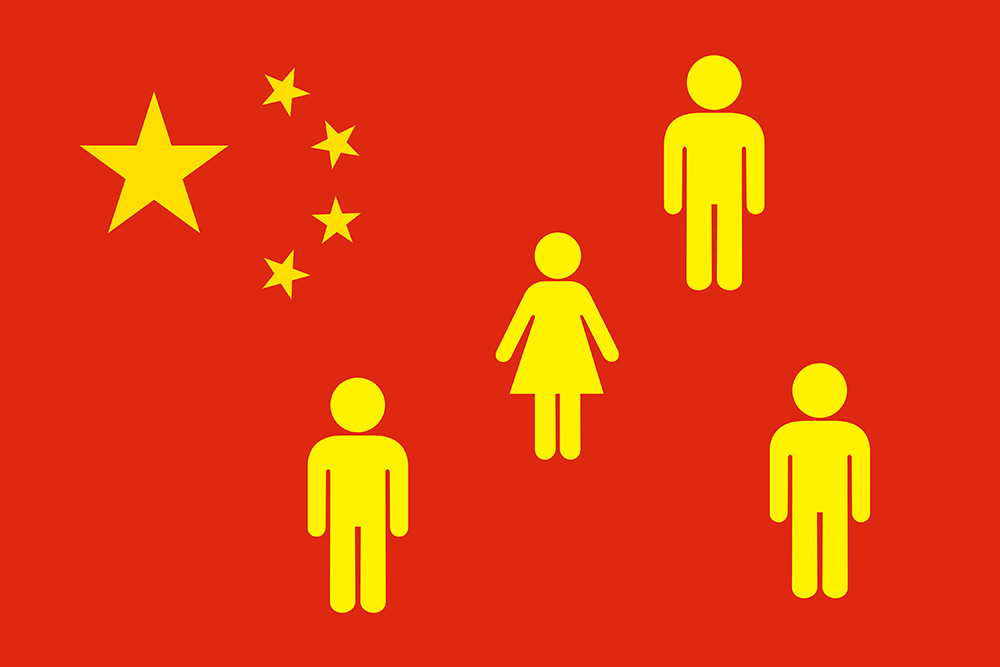Too Many Boys
Written by Paul Siluch
June 22nd, 2023
The idea that male children are superior to female children is very prevalent throughout history, and sadly still lingers in many countries today. Male children – at least the first born ones – traditionally inherited the family lands and titles, while girls often required that parents pay a dowry to marry them off.

Procession of Princes – Dresden, Germany
It didn’t always make the most sense, in hindsight. Girls were better caregivers for aging parents and boys die at a higher rate due to higher infant mortality and higher adolescent idiocy (as a former male teen, I can attest to such idiocy).
Sex selection was practiced in most parts of the world throughout the Middle Ages, including Europe, Asia, and India. This led to a surplus of young men unable to find wives, and that was when problems started. Rootless bachelors tend to be more migratory, form gangs, and are more violent than married men. Research shows that men actually calm down once married:
“Serum testosterone levels fall during the years surrounding marriage. Changing levels may explain the low criminality found among married men. . . . Married men, living stably with their wives, are less prone to crime than unmarried men.”
- Marriage, Divorce, and Male Testosterone” – Allan Mazur and Joel Michalek
A preponderance of men did not always lead to violence, but like dry tinder, all it took was a spark to ignite a revolution.
The solution? Many countries started wars to grow their territory. If a few of the “surplus men” were culled as a result, well, that was icing on the cake. Portugal experienced too many ‘noble sons’ at their empire’s peak in the 1500s. They responded by invading Africa.
So what does that have to do with today, and Father’s Day in 2023?

As much as we’d like to think parents selecting for boys is an outdated anachronism, it isn’t. Particularly in Asia. The graph above shows the sharp increase in sex ratios at birth of various nations favouring male children. There was a rapid increase around 1980.
What changed? The advent of scanning technology to determine a baby’s sex before birth is what changed. Parents could see the sex of their child early in the pregnancy.
China’s one child policy exacerbated this trend sharply, with millions of families choosing to have a boy over a girl. By the year 2002, there were approximately 40 million “excess” boys in China. India, which never had a one-child policy but has long favoured boys over girls, had 30 million excess boys (source: Institute of Child Health, University College London).
China even has a name for unmarried men unable to find wives. They call them “bare branches” because the family tree will end with them.
South Korea solved their imbalance by strict laws and penalties in the early 1990s. Korean girls in the last 20 years have enjoyed a period where they could “marry up” because of their scarcity. The imbalance risk is largely over in that country.
The 70 million excess Chinese and Indian boys born at the turn of the millennium are in their early twenties now. And they have no prospect of ever finding wives.
China was able to fill its factories with surplus male labour. Until now. China’s youth unemployment today is close to 20%, a result of the pandemic and China’s weak economic rebound. China has bulked up its People’s Liberation Army, as a result, using the army as a place to ‘park’ many of its surplus men. It’s not enough, though.
History shows that imbalanced nations tend to become more autocratic and less democratic, a trend we have certainly witnessed in China over the past decade. India has also become less democratic, or at least is governed to favour the Hindu majority.
And since history suggests nations often use war to deal with this problem, we can’t help but notice the increasing tensions along the Himalayan border between China and India. They have been rivals for years but things have been heating up in recent years.
In a previous letter, we discussed the book called The Fourth Turning. The premise was that we are now in the most tumultuous time of history, the final 25 years of the hundred year cycle when changes and crises peak. The demographic imbalance cresting today in China and India certainly adds tinder to that fire, and we can only hope that India’s reindustrialization keeps its young men busy, while the renewed trade talks between America and China bring some semblance of calm to our troubled relationship.
In the meantime, the whole issue circles back to balance. Canada, the U.S., and Africa have remarkably balanced sex ratios. China and India have since recognized the value of women and are enforcing birth balance, as we can see in their declining curves above.
All of these should help to lower the risk of “too many boys.” Once we get past this decade.
Fatherhood – and the opportunity of fatherhood – matters.
Happy Father’s Day!
Markets This Week
The boogeyman of markets for the last 18 months has been inflation. Central banks are trying to strangle it with high interest rates, and they aren’t done.
But, markets are looking past this. Investors hope we are close to being finished with hikes and rates could start to fall soon. So hopeful.
But how likely is this?
The biggest component of the inflation index – the CPI, or Consumer Price Index – is housing.

Specifically, CPI measures Owner’s Equivalent Rent, or how much you think you could rent your house for. Here’s the question on the monthly survey:
“If someone were to rent your home today, how much do you think it would rent for monthly, unfurnished and without utilities?”
Do you know that number? Most people don’t, to be honest. And they are slow to change their minds every month once they come up with a number.
These surveys show rents rising at 8% per year – the orange line. This pushes overall CPI way up to 5.3%.
That’s the grey line:

However, we have something called “the internet” now which can measure actual rents by the minute nationwide. Real-time rents are increasing by only 2.1% year-over-year (the yellow line). The monthly government survey is way out of line with reality.
As a result, investors know inflation is lower than the 5.3% reported, and expect interest rates to start dropping. That is a big reason why markets have been optimistic.
The problem?
CPI misses another big cause of inflation – wages. Labour costs represent roughly two-thirds of the total costs to private U.S. businesses. (Bureau of Labor Statistics). Wages feed inflation.
Over the last decade, wages rose about 2% per year. Since 2021, wages have more than doubled to 4.8% per year (BLS.gov):

Read the news. You can feel the tension with all the recent strikes:
- West Coast dockworkers will see a cumulative 32% pay raise over the next 5 years.
- FedEx pilots pay raise of 30% was seen in addition to a similar increase in pensions.
- Delta and Spirit workers got pay gains north of 30%.
- UPS workers are preparing to strike at the end of July.
- United Airlines pilots union authorized a strike vote.
- 7,000 Teamsters at TForce Freight have overwhelmingly voted to authorize a strike.
Conclusion:
Inflation is probably headed lower, thanks to falling rents. Interest rate hikes can stop soon.
…but
Inflation is probably not going down as much as we think, thanks to wages. Rates will stay higher for longer than we want.
Most growth stocks are not priced for this.
AI – Who Benefits Most?
There is an old adage about technology that I try not to forget:
- We overestimate the impact of a new technology in the short term.
- We underestimate its impact in the long term.
For example, when the “world wide web” – which we now call the internet – first came into global use in the late 1990s, we went crazy over the suppliers of the routers, switches, and fibre optic cables. We ordered too much of everything in our frenzy and wrapped the world four times over with empty cables.
And then all of those companies went broke.
In the short-term, we overestimated how many books we would buy on-line and overbuilt everything.
By 2010 – just a decade later, those empty cables? Full of data. And we needed more.
What filled them? Google went public in 2004. Amazon Prime arrived in 2005 to sell more than just books. YouTube took off in 2006, and the iPhone was introduced in 2007. Facebook and Instagram followed.
We underestimated the long-term impact of the internet and unlimited bandwidth.
So which companies and industries really benefitted the most from the internet?
New companies, like Google, benefitted for sure. But it was old industries that were completely changed that really took off.
The taxi industry became Uber. The travel industry was completely transformed by Priceline. Hotels by Airbnb. Many other traditional industries like banking and credit cards – Visa, for example – experienced huge productivity gains by embracing the new efficiencies of the internet.
And that is exactly what we are likely to see with Artificial Intelligence, or AI as it is widely known. Many market observers anticipate that Nvidia (the maker of chips) and Microsoft (the buyer of these chips for its cloud services and the new ChatGPT service) will be the biggest beneficiaries. History suggests it will be old, inefficient industries that benefit most.

For example, Kraft-Heinz - a very traditional food company - recently mentioned in its earnings call that sales rose by $30 million using AI. Will the rail industry benefit with optimized routes? Will miners use AI to discover new mineral deposits faster?
Yes, and yes.
In the short-term, the AI boom is a bubble that will pop. The companies we see as the winners will fade, as their valuations are just too high.
In the long-term, new companies will take AI in new directions and old companies will make productivity leaps with all this new intelligence. Health care and disease diagnosis come to mind.
The Old Economy could see the biggest gains, and that is precisely where no one is looking today.





